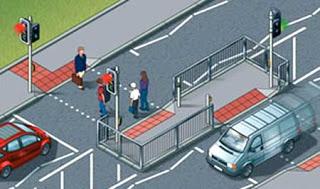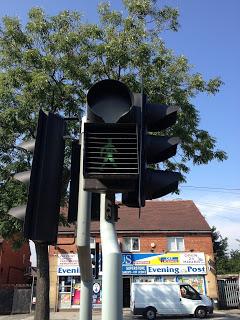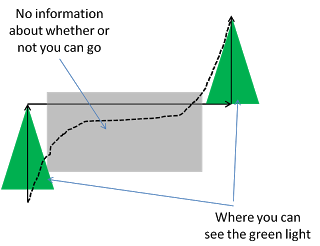Design is interesting for embodied cognition because it's an attempt to artificially manipulate the environment to create affordances for some but not other behaviours. Sometimes it's just a matter of getting the physical layout right (see the Spudnik). Some of these required behaviours, however, are quite complex and not the sort of thing that would typically create information if left to their own devices. A great example is the design of streets to promote safe driving and pedestrian behaviour; a lot of the rules being designed for are human conventions, not physical necessities, and so without someone intervening and building something there couldn't be perceptual information anywhere about that rule. In addition, the designed element often creates information about something other than itself (see the Aboutness dimension in Sabrina's information taxonomy). This in turn creates the possibility for there to be more than one way to create an environment that produces relevant information and can therefore shape behaviour, and in turn, this allows the possibility that some designs will be better than others.
With this in mind, let me introduce you to two examples of design that I would like to change; the staggered pedestrian crossing, and puffin crossings. Both of these artificially restrict access to useful information in ways that mean well but that I think fight too much against human behavior. I actually started preparing a grant to empirically investigate these designs from a more embodied perspective, and the EPSRC thought it was in their ballpark. More pressing concerns intervened, but I would love to actually do these studies and would like to hear from anyone who might be interested in collaborating ("Dear Pamela lab..."). I think our embodied cognition approach (Wilson & Golonka, 2013), with it's focus on task analyses and information, could really have an impact on an interesting part of our day to day life.
Staggered crossings

Note that in the real world, there's also a lot of fences forcing people to cross at the lights
A staggered pedestrian crossing is one in which you cross the road in two stages. You cross one side, walk down a little island, then cross to the other side. The lights for each stage are independently controlled. The general guideline for building these is to make you walk so as to face oncoming traffic as you cross the island in the middle; this is so you can see what's coming up traffic wise. This is only a guideline, however, and there are many staggered crossings in the UK where this isn't possible for some reason, and the stagger goes the other way.The basic idea is not a bad one; use a series of fences to guide pedestrians to walk in a particular way across a road. (NB Missing from that picture are the many fences required to make pedestrians enter the crossing at the right point!) However, staggered crossings include a design feature that fights against what I'm pretty sure will be the pedestrian behavior that emerges from this layout, and it drives me slightly mental whenever I encounter it.
The feature is this: blinders on all green signals after the one controlling your first crossing.


A schematic of the staggered crossing light setup
In order to be able to obey the lights at a staggered crossing, you must walk straight across the first crossing, turn, walk down the island until you are nearly directly across from the next signal, turn, wait till it's green then cross. In effect you have to walk as depicted by the arrows (as the imposed trajectory).
I see two problems with this.
- There are large portions of the trajectory where you have no information about whether you can cross. This leaves the pedestrian in limbo about what is coming up until very late, and given that it takes time to move and change direction our perceptual systems are typically hungry for information about what's next, rather than what;s going on right now.
- You are being asked to walk to a point, stop, turn, walk, stop, turn, check and only then go if it's indicated. People don't typically walk like this; turning on a right angle is actually hard when you're moving because of your inertia, so real locomotion trajectories change direction as smoothly as possible. I've added in a dotted line to indicate my guess as to the preferred trajectory people will try to take given the affordances (spatial layout) of the staggered crossing. The path cuts corners, it wants to turn early and it therefore wants to know whether it can go as soon as possible. (Pedestrian control designers know about these kinds of paths, which they charmingly refer to as 'desire lines').
The designer reply is 'so what? I'm trying to make people behave responsibly'. This is all well and good but it's fighting with people's preferred locomotion (a preference that is supported by the spatial layout of the stagger and by the control requirements of walking) and my bet is that in that fight, design loses nearly every time.People will cheat and make bad decisions rather than obey the imposed trajectory.
My project idea: I think that the relevant desire lines emerge from people moving through a specific spatial layout (i.e. this layout affords some and not other paths to moving people). I think that restricting access to the green signals is an unnecessary precaution that leaves people operating in a 'no information' setting (and this can be disastrous). I think you can build a staggered crossing that works with human locomotion, and not against it.
I would first like to collect data from real staggered crossings and measure people's behavior (what are the desire lines given this layout?). I'd then like to model that behavior (perhaps by adapting an existing model, e.g. Fajen & Warren, 2003, or Wilkie & Wann, 2005). I'd give the model the layout of the staggered crossings and replicate the observed trajectories. Then, I'd adjust the layout presented to the model to see what happens and if we can identify a better form. Then I'd record real people walking through real layouts in the new forms (and old forms with continuous access to green light information) to see if they behave more usefully. Warren at least has gotten his model working in multi-agent settings (he gave a great talk at VSS2013 on this stuff) and it's specifically about walking; Wilkie & Wann are more about navigating at higher speeds (e.g. driving). I think this task would make a kick-ass test bed for testing these models, though.
The main thing I'd need (besides access to crossings I could film and the technology to do so, problems I had in principle solved when I was working this up) is the ability to test novel layouts. A gym and some fencing might do the trick, but if anyone reading this works at the Pamela lab, call me; I may yet call you!)
Puffin crossings
In my research for the above project, I found out about the different kind of crossing systems. There are pelican crossings (the familiar kind you see most everywhere), toucan crossings (for both bikes and people - 'two can' cross, get it? Ha!) and puffin crossings. Puffins are the new big thing and are supposedly getting phased in throughout the UK.I hate them and I want them to die.
The idea, again, is not a bad one. Puffin crossings put the green light next to the waiting pedestrian, rather than across the road. This makes it easier to see, especially on bright days and for visually impaired users. They also have some sensors and changes to the way they cycle that make them a bit more responsive.
But again the problem is about removing access to information. With a puffin crossing, as soon as you leave the sidewalk, you can no longer see any lights, and you have no idea whether the crossing is still good. Actually, the information about whether it's safe to cross is not where people typically look - at their upcoming path across the road, and not down the road at the traffic where puffin crossing designers think they are looking.
There are two common cases where this is a problem; when you've run onto the crossing in the middle of the cycle and you don't know how much time you have left, and when you are slow for some reason (for instance, older adults) and you might want to know if you're about to hold up all the traffic. I saw an elderly lady nearly get killed on one of these; she started crossing very slowly and immediately had no idea whether she was still allowed to cross; no green signal anywhere. She stopped, turned, and came back very distraught and had to try again.
When people are moving they don't like to simply get going and then cast themselves adrift from information about how things are going. All actions entail ongoing, real time monitoring of progress and at a crossing, green signal lights are part of that. I'm not especially slow and even I find these crossings very disconcerting; it's like the green light has turned off once I head out, rather than just swung out of view.
My project idea: For this one I'd mostly like to find out if I'm right in my intuitions that the absence of a visible green light throughout the crossing affects people's locomotion. Video from an established crossing (ideally before and after the the transition from pelican to puffin crossing) would be about all that's needed. I suspect these things are a terrible idea and would love to be able to back that up. Impact case study for the next REF, anyone?
Summary
Embodied cognition means, fundamentally, getting serious about the environment and information about that environment. When you do, you see very different solutions to problems that (so far) typically work much better than the old solutions (see our review of the successes of embodied cognition in our Frontiers paper). Safe pedestrian locomotion through a paved world designed for cars is a place where this work might really make an interesting difference, and one day, I will run these studies!
References
Fajen, B. R., & Warren, W. H. (2003). Behavioral dynamics of steering, obstacle avoidance and route selection. Journal of Experimental Psychology: Human Perception & Performance, 29(2),, 343-362. DownloadWilkie, R. M., & Wann, J. P. (2005). The role of visual and nonvisual information in the control of locomotion. Journal of Experimental Psychology: Human Perception & Performance, 31(5), 901-911. Download
Wilson, A. D., & Golonka, S. (2013). Embodied cognition is not what you think it is. Frontiers in Psychology, 4, 58. Download

